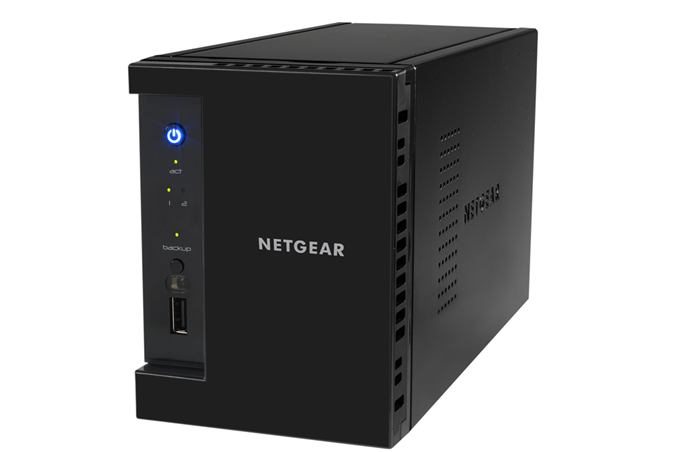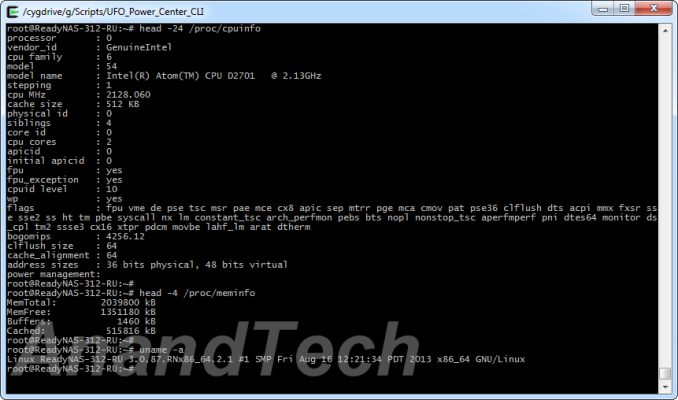Netgear ReadyNAS 312 2-bay SMB / SOHO NAS Review
by Ganesh T S on November 11, 2013 1:00 PM EST- Posted in
- NAS
- IT Computing
- NetGear
- ReadyNAS

Introduction
x86-based NAS units targeting SMB consumers are usually of the 4-bay or more variety. However, there is a growing market for 2-bay high-performance units. Almost all major NAS vendors have an Atom-based 2-bay SMB NAS unit. We have not reviewed any 2-bay x86-based NAS units before, but a number of such units have been evaluated in our testbed. Over the next couple of weeks, we will be looking at some notes from our evaluations. Today, we are going to look at Netgear's 2-bay SMB offering, the ReadyNAS 312.
Netgear's storage lineup has been in a bit of flux over the last few years. While the x86-based versions have been quite stable, their SOHO / home consumer lineup had to shift from SPARC-based units to ARM-based ones. We covered the reboot of the ReadyNAS OS for ARM-based units in the review of the ReadyNAS NV+ v2. Despite Netgear's promise to work on adding features and making the new ReadyNAS OS better to use, here we are, two years later, looking at yet another reboot of the ReadyNAS OS.
In terms of redesign, ReadyNAS OS 6.0 is the most ambitious yet. Unlike other NAS vendors who opt for the safety of the proven EXT3 / EXT4 file system for the internal volumes, Netgear has opted for the cutting-edge BTRFS. The benefits of BTRFS over EXT3 / EXT4 are numerous. These include checksumming for integrity, in-built snapshotting mechanisms, continuous defragmentation, online data compression, scrubbing with error correction and built-in storage pools which make a separate LVM unnecessary. Compared to ZFS, the memory requirements are more manageable, but, deduplication support in ZFS is much better. However, there is an impression amongst some IT folks that btrfs is not stable enough for deployment in production environments. Netgear indicates that btrfs is part of Oracle's production kernel and, currently, the same code and kernel are being used in ReadyNAS OS 6.x.
The specifications of the RN312 are provided below:
| Netgear ReadyNAS 312 Specifications | |
| Processor | Intel Atom D2701 (2C/4T, 2.13 GHz) |
| RAM | 2 GB DDR3 RAM |
| Drive Bays | 2x 3.5"/2.5" SATA 6 Gbps HDD / SSD (Hot-swappable) |
| Network Links | 2x 1 GbE |
| USB Slots | 2x USB 3.0 / 1x USB 2.0 |
| eSATA Slots | 1x |
| Expansion Slots | None |
| VGA / Display Out | HDMI |
| Full Specifications Link | Netgear ReadyNAS 312 Full Specificatios |
The ReadyNAS 312 runs a Linux kernel (v3.0.87). Other interesting aspects of the platform can be gathered after gaining SSH access into the unit.
In the rest of the review, we will cover the setup and usage impressions followed by a description of our testbed setup and testing methodology for the ReadyNAS 312. This is followed by benchmarks in single and multi-client modes. For single client scenarios, we have both Windows and Linux benchmarks with CIFS and NFS shares. We will also have some performance numbers with encryption enabled. In the final section, power consumption numbers as well as RAID rebuild times will be covered along with some closing notes.











18 Comments
View All Comments
anactoraaron - Monday, November 11, 2013 - link
The only thing that I would add is that Netgear is really taking their ReadyNAS product line seriously with their support. I reviewed on of these units as well (mine came with 2x 1TB Toshiba drives included) and I had some very strange issues with the software (6.0.8). Without going into the details (ejecting external usb drives was one), I notified Netgear about the issue they had a firmware fix the next Monday (firmware was originally 6.0.8 - and was updated to 6.1.1). To me, that was a huge plus. Knowing that your support ticket,etc would be investigated and getting such a fast patch issued shows their commitment to this product line.jaydee - Monday, November 11, 2013 - link
Ganesh,I'm wondering how likely is it, if you were to buy/use this in a home, to actually use the OS that comes with the system, rather than WHS 2011, or a Linux-based server OS (CentOS, etc)? Can you go a bit further with the software aspect of it?
anactoraaron - Monday, November 11, 2013 - link
I would just use the OS that comes with it. There's other features of the OS (like Power Timer) that allow you to set a schedule for when the NAS is on - and it also has WOL functionality. Inside the OS is support for SMB, AFP, NFS, FTP, iTunes, ReadyDLNA, etc. Also in the OS is a free antivirus.There's also a one touch backup button that can be configured to whatever you want to backup (like just certain shared folders) or you can schedule automatic backups. There's nothing too special about the OS, but there's really nothing missing from it either.
ganeshts - Monday, November 11, 2013 - link
I agree with anactoraaron. This is an off-the-shelf NAS. If the software features don't fit, you are better off with a WHS server or custom Linux DIY build. Also, as far as I can see, the only complaint that can be put forward 'core-feature-wise' is the lack of LVM support -- i.e, say, you get the 4-bay variant and want to store some data with single disk resiliency and some with dual disk resiliency -- it is not possible with ReadyNAS OS 6.x.tuxRoller - Monday, November 11, 2013 - link
BTRFS includes "lvm" just as zfs does. In fact, that's one of its criticisms.Since btrfs supports redundancy using the chunks model (default 256MB), rather than at the disk level, you can have multiple redundancy options within a single disk (not a great idea for multiple reasons, but should be doable). Of course, you can span this over multiple disks to get the desired effect.
Something like:
mkfs.btrfs -m raid 1 -d /dev/sda -d raid 1 /dev/sdb /dev/sdc
I should think.
ganeshts - Monday, November 11, 2013 - link
I did mention btrfs's LVM support in the article, but the problem is that Netgear's firmware doesn't implement it.tuxRoller - Monday, November 11, 2013 - link
In the article you said it was supposed to be using the code that was employed in Oracle's deployments?ganeshts - Monday, November 11, 2013 - link
Yes, but not all features are exposed to the end-users. I guess the really adventurous users could try out certain things over SSH, but without official support, it is going to be pretty dangerous.jaydee - Monday, November 11, 2013 - link
The feature I had in mind was proxy server for web caching, content filter, security (something like Squid). I realize this is kinda getting away from a "NAS", but with the specs listed, I don't see why it couldn't.bsd228 - Monday, November 11, 2013 - link
While Oracle may now include it, Redhat is still on the fence about it with the upcoming RHEL7, and still is working out stability before endorsing it for performance reasons. If you want a better filesystem, you can get an HP Microserver and pair it with zfs. I'll let others take this netgear experiment.